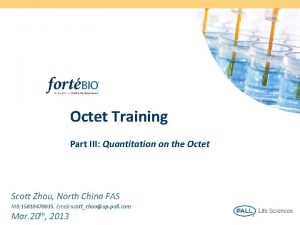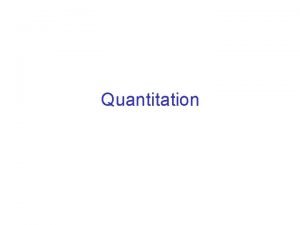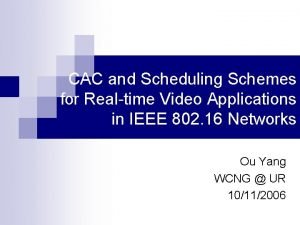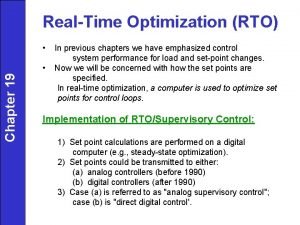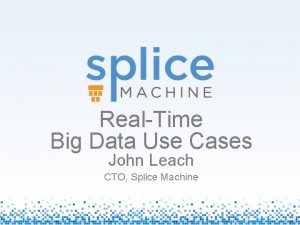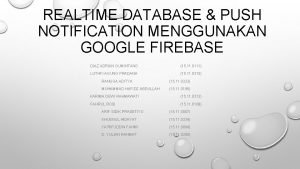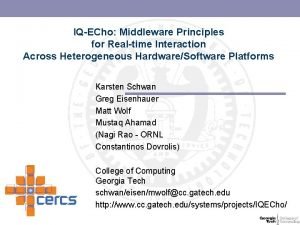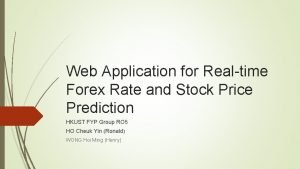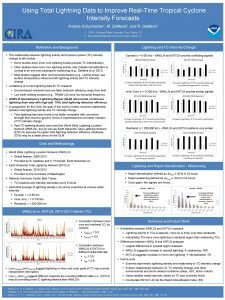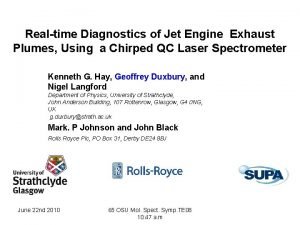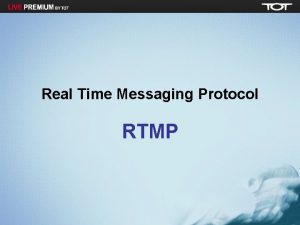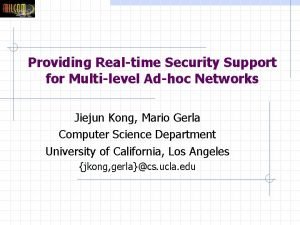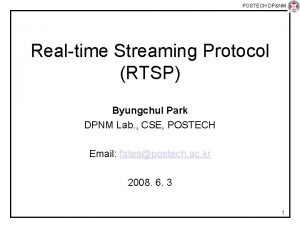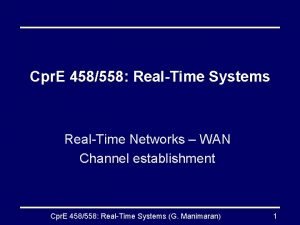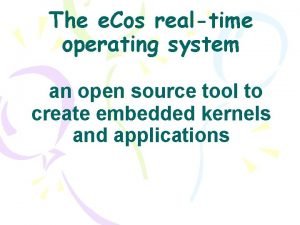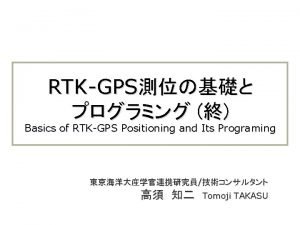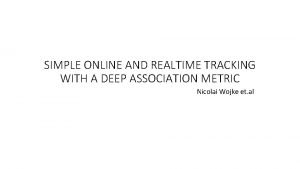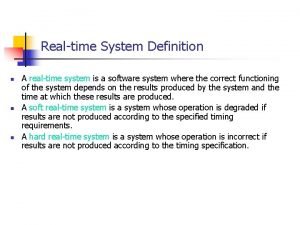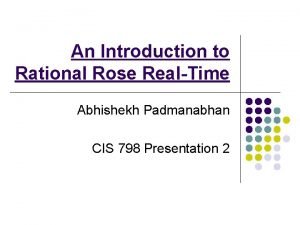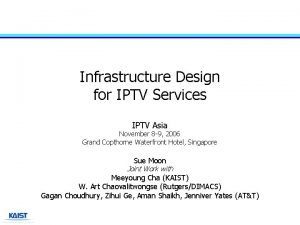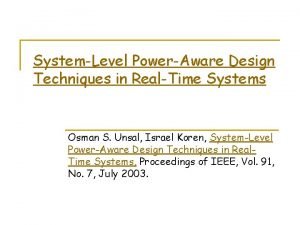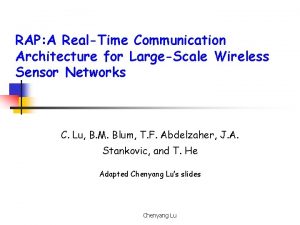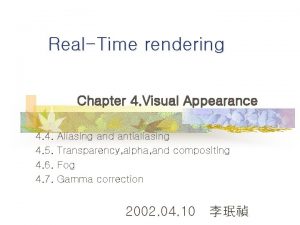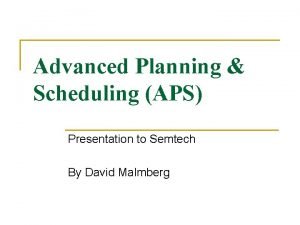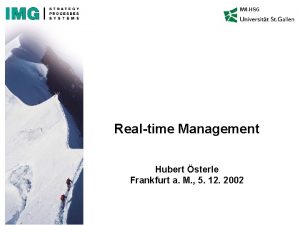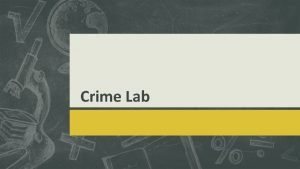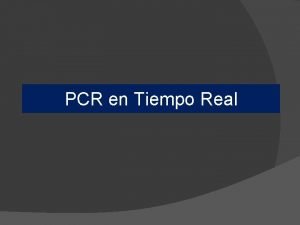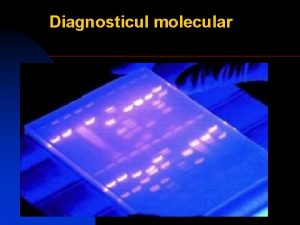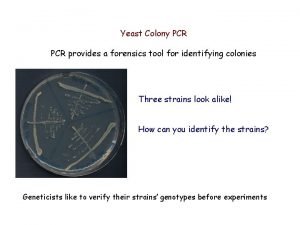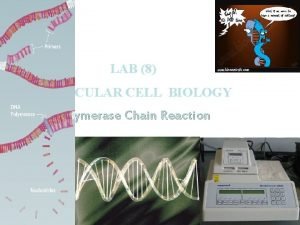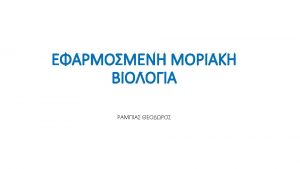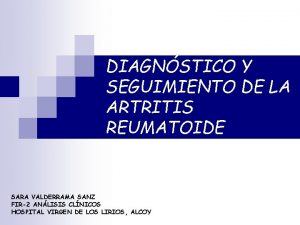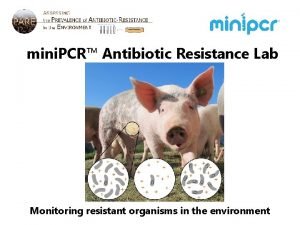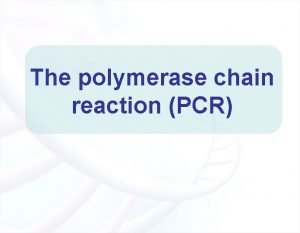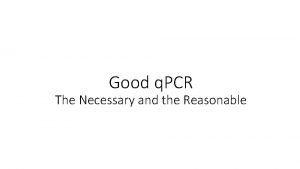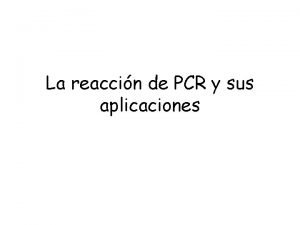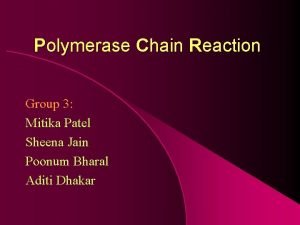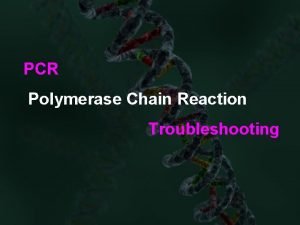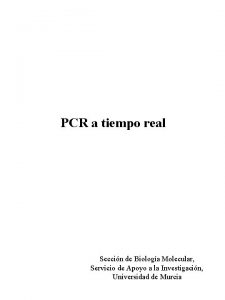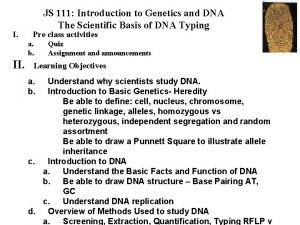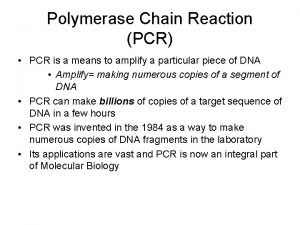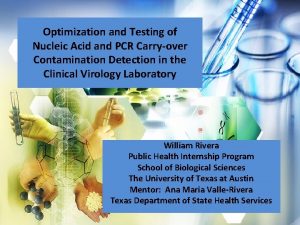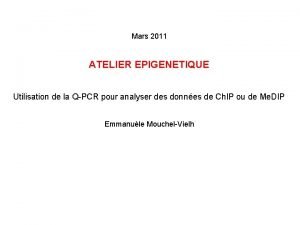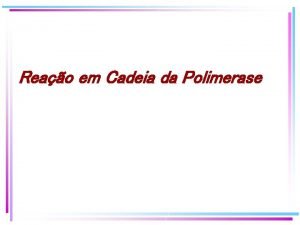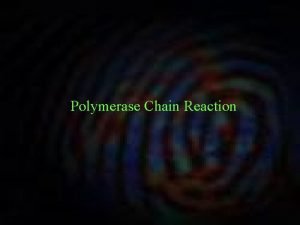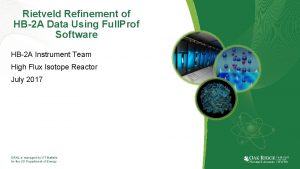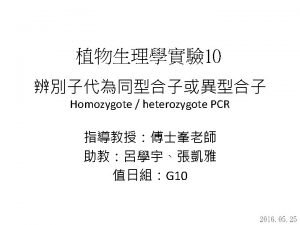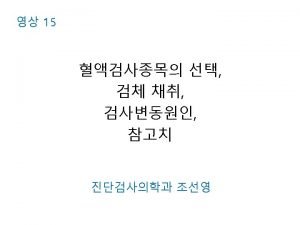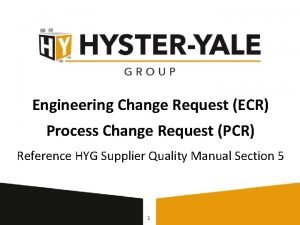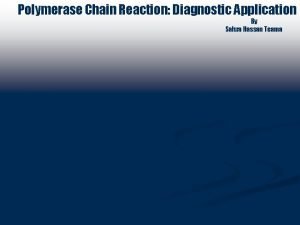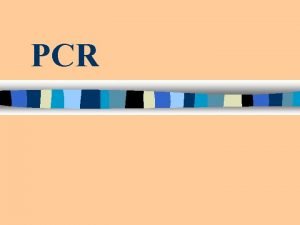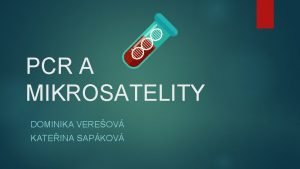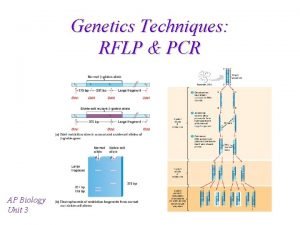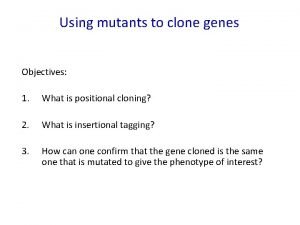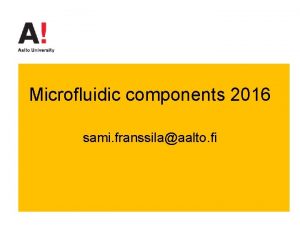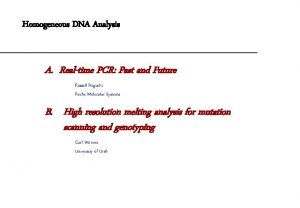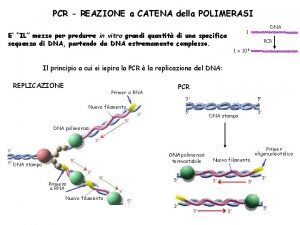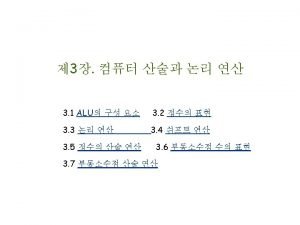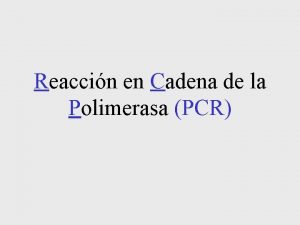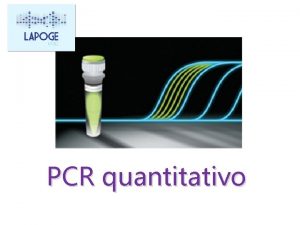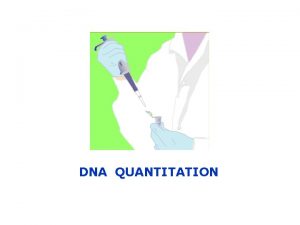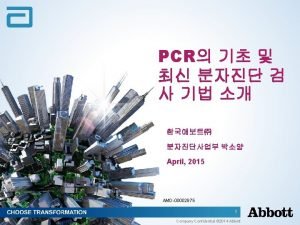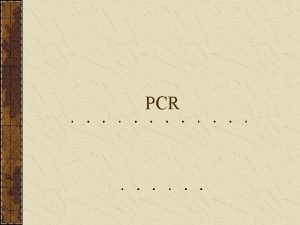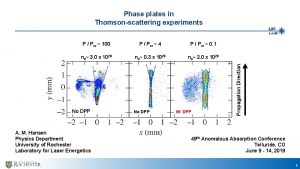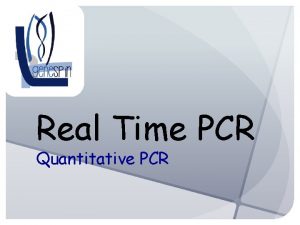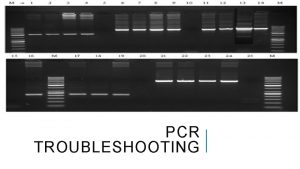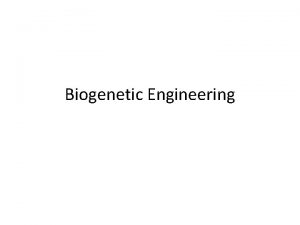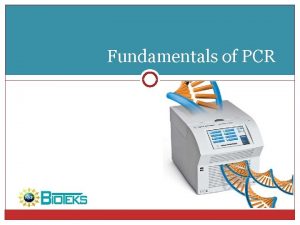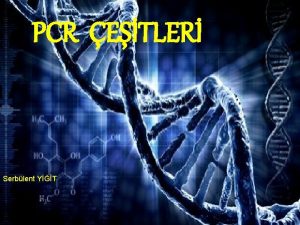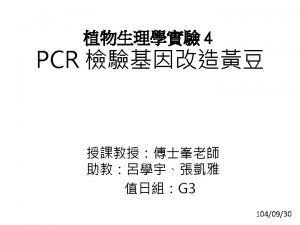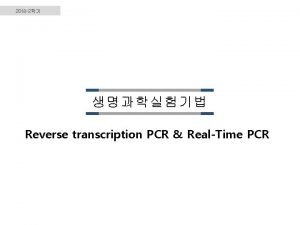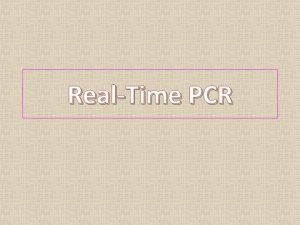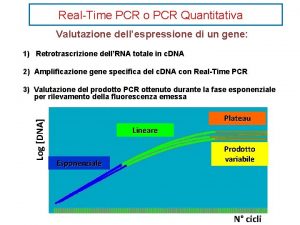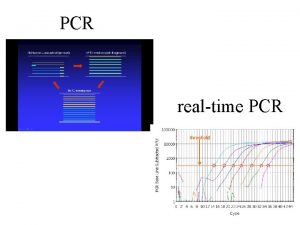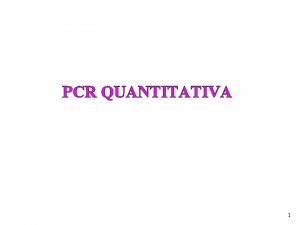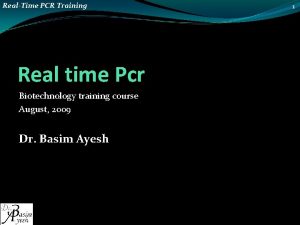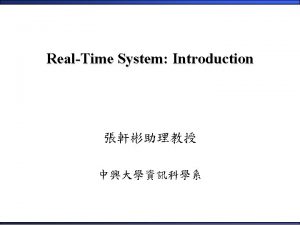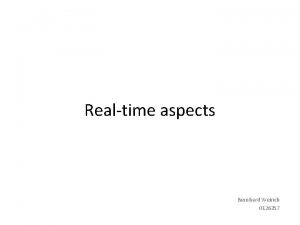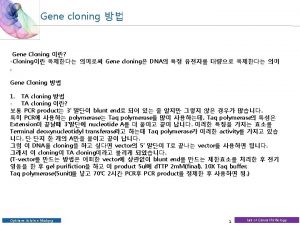PCR quantitation What is RealTime PCR RealTime PCR
















































![E = 10 [– 1/slope] E = 10 [– 1/slope]](https://slidetodoc.com/presentation_image_h2/60624f6c3de2b28da7b307c7a9f87d8d/image-49.jpg)












![ΔΔCt method experiment control -[(Cttg-Ctcg)-(Cttg-Ctcg)] 2 Ex! D Ct = target gene– ref gene ΔΔCt method experiment control -[(Cttg-Ctcg)-(Cttg-Ctcg)] 2 Ex! D Ct = target gene– ref gene](https://slidetodoc.com/presentation_image_h2/60624f6c3de2b28da7b307c7a9f87d8d/image-62.jpg)




















- Slides: 82

PCR quantitation


What is Real-Time PCR? Real-Time PCR is a specialized technique that allows a PCR reaction to be visualized “in real time” as the reaction progresses. This enables researchers to quantify the amount of DNA in the sample at the start of the reaction!

What is Real-Time PCR? Differences with normal PCR? • 20 ul PCR reactions • SYBR Green or probes § § 94°C 4 min 94°C 15 sec 40 x 61°C 30 sec 72°C 30 sec

What is Real-Time PCR used for? Real-Time PCR has become a cornerstone of molecular biology: • Gene expression analysis – Medical research (SNP, tumor and normal, signaling pathway) – Drug research • Disease diagnosis – Viral quantification • Food testing – Percent GMO food • Transgenic research – Gene copy number

What is Real-Time PCR? Taq polymerase can only synthesize DNA, so how do we study gene expression (RNA) using q. PCR? Reverse transcription RNA -> DNA (c. DNA)

What’s Wrong With Agarose Gels? Low sensitivity § Low resolution § Non-automated § Size-based discrimination only § Results are not expressed as numbers based on personal evaluation § Ethidium bromide staining is not very quantitative § End point analysis §


PCR The amount of DNA doubles after each cycle Assuming 100% efficient PCR reactions After n cycles there will be 2 n times as much DNA


Gel base detection

Reporter in q. PCR

Reporter in q. PCR

Reporter in q. PCR

PCR The amount of DNA doubles after each cycle Assuming 100% efficient PCR reactions After n cycles there will be 2 n times as much DNA

16

Plot of real time pcr


• Rn: Normalized reporter is the ratio of the fluorescence emission intensity of the reporter dye to the fluorescence emission intensity of the passive reference dye • ΔRn is the normalization of Rn obtained by subtracting the baseline: (ΔRn = Rn –baseline).

20

Linear ~20 to ~1500 21

Linear ~20 to ~1500 Fluorescent Units PCR baseline subtracted RFU Arithmetic scale Same region as log scale Cycle number

threshold = 300 23

Amplification curve: log view Plateau Linear Exponential Always use during analysis Amplification curve: linear view

Endpoint analysis Different concentrations give similar endpoint results!

Imagining Real-Time PCR …So that’s how PCR is usually presented. To understand real-time PCR, let’s imagine ourselves in a PCR reaction tube at cycle number 25…

Imagining Real-Time PCR What’s in our tube, at cycle number 25? A soup of nucleotides, primers, template, amplicons, enzyme, etc. ~1, 000 copies of the amplicon right now.

Imagining Real-Time PCR How did we get here? What was it like last cycle, 24? Almost exactly the same, except there were only 500, 000 copies of the amplicon. And the cycle before that, 23? Almost the same, but only 250, 000 copies of the amplicon. And what about cycle 22? Not a whole lot different. 125, 000 copies of the amplicon.

Imagining Real-Time PCR How did we get here? If we were to graph the amount of DNA in our tube, from the start until right now, at cycle 25, the graph would look like this:

Imagining Real-Time PCR So where are we going? What’s it going to be like after the next cycle, in cycle 26? Probably there will be 2, 000 amplicons. And cycle 27? Maybe 4, 000 amplicons. And at cycle 200? In theory, there would be 1, 000, 000, 000, 000, 000, 000 amplicons… ?

Imagining Real-Time PCR If we plot the amount of DNA in our tube going forward from cycle 25, we see that it actually looks like this: So where are we going? • • Realistically, at the chain reaction progresses, it gets exponentially harder to find primers, and nucleotides. And the polymerase is wearing out. So exponential growth does not go on forever!

Imagining Real-Time PCR Measuring Quantities How can all this be used to measure DNA quantities? ? What if YOU started with FOUR times as much DNA template as I did? I have 1, 000 copies at cycle 25. You have 4, 000 copies! So… You had 2, 000 copies at cycle 24. And… You had 1, 000 copies at cycle 23.

Imagining Real-Time PCR Measuring Quantities So… if YOU started with FOUR times as much DNA template as I did… Then you’d reach 1, 000 copies exactly TWO cycles earlier than I would!

Imagining Real-Time PCR Measuring Quantities What if YOU started with EIGHT times LESS DNA template than I did? You’d only have 125, 000 copies right now at cycle 25… …and you’ll have 250, 000 at 26, 500, 000 at 27, and by cycle 28 you’ll have caught up with 1, 000 copies! So… you’d reach 1, 000 copies exactly THREE cycles later than I would!

The “ct value” Imagining Real-Time PCR • • The value that represents the cycle number where the amplification curve crosses an arbitrary threshold. Ct values are directly related to the starting quantity of DNA, by way of the formula: Quantity = 2^Ct Ct Values: Measuring Quantities 23 Threshold 25 28


threshold Ct

Imagining Real-Time PCR Measuring Quantities There’s a DIRECT relationship between the starting amount of DNA, and the cycle number that you’ll reach an arbitrary number of DNA copies (Ct value). DNA amount = 2 ^ Cycle Number

How do We Measure DNA in a PCR Reaction? We use reagents that fluoresce in the presence of amplified DNA! Ex. SYBR Green dye They bind to double-stranded DNA and emit light when illuminated with a specific wavelength.

• ds. DNA intercalating dye • Unspecific (optimization) • cheap SYBRgreen How do We Measure DNA in a PCR Reaction? 5’ 3’ Extension 3’ 5’ ID 5’ Taq ID ID Taq 5’ ID 3’ Apply Excitation Wavelength l l 3’ 5’ l ID ID ID Taq l ID l Taq 5’ ID 5’ 3’

Melting curve – Test the presence of unspecific amplification, contamination, primer dimers, . .

Taq. Man probes • Sequence-specific • Doesn´t need much optimization • More expensive

What Type of Instruments are used with Real. Time PCR? Real-time PCR instruments consist of TWO main components: • Thermal Cycler (PCR machine) • Optical Module (to detect fluorescence in the tubes during the run)

What Type of Instruments are used with Real. Time PCR? • Adequate, optical plates Ø 96/384 wells Ø Standard/fast • Optical sealing adhesive



Quantification and Normalization • First basic underlying principle: every cycle there is a doubling of product. • Second basic principle: we do not need to know exact quantities of DNA, instead we will only deal with relative quantities. • Third basic principle: we have to have not only a “target” gene but also a “normalizer” gene. • Key formula: Quantity = 2 ^ (Cta – Ctb)

Standard Curve Quantification and Normalization Prepare a 2 -fold serial dilution of a DNA sample: Recomendation: add always a standard curve in every run
![E 10 1slope E = 10 [– 1/slope]](https://slidetodoc.com/presentation_image_h2/60624f6c3de2b28da7b307c7a9f87d8d/image-49.jpg)
E = 10 [– 1/slope]


E = 10^(-1/slope) E = (10^(-1/slope)-1)*100 Ex. slope = -3, 81 efficency= (10^(-1/-3. 81)-1)*100 = 83% Ideal: efficency >95% 51


IL 1 -b vit RPLP 0 con RPLP 0 vit IL 1 -b con 53

EFFICIENCY DDCt METHOD APPROXIMATION METHOD 54

IL 1 -b vit RPLP 0 con RPLP 0 vit IL 1 -b con 55

56

control D Ct = target - ref RPLP 0 con D Ct = 9. 70 IL 1 -b con av =19. 93 experiment av =29. 63 D Ct = target - ref IL 1 -b vit D Ct = -1. 7 RPLP 0 vit av =18. 03 av =19. 80 Difference = DCt-DCt = DDCt = 9. 70 -(-1. 7) = 11. 40 57

DDCt = 11. 40 for IL 1 -beta • 2 DDCt variant: assumes efficiency is 100% Fold change = 211. 40 = 2702 • But our efficiency for IL 1 -beta is 93% – Fold change = 1. 9311. 40 = 1800 • Pfaffl equation corrected for RPLP 0 efficiency – Fold change = 1901 58

IL 1 -beta IL 1 -b vit IL 1 -b con av =18. 03 av =29. 63 AFTER N CYCLES: change = (efficiency)n AFTER N CYCLES: ratio vit/con = (1. 93)29. 63 -18. 03 =1. 9311. 60 = 2053 59

RPLP 0 con RPLP 0 vit av =19. 80 av =19. 93 AFTER N CYCLES: change = (efficiency)n AFTER N CYCLES: ratio vit/con = (1. 87)19. 93 -19. 80 =1. 870. 13 = 1. 08 60

Quantification and Normalization “normalizer” gene • Knowing the amount of m. RNA in one sample from one specific gene does not tell us much. . • You need to know the total amount of m. RNA in your sample • You also dont know how much the m. RNA level has changed compared to other m. RNA levels • Example: m. RNA levels of a gene increase 2 x after induction It is possable that all (1) genexpression in the cell has increased (2) the induced samples contained more total m. RNA We have to compare the expression of our gene to another gene which expression is normally constant, a housekeeping gene (ex. TBP, 18 S)
![ΔΔCt method experiment control CttgCtcgCttgCtcg 2 Ex D Ct target gene ref gene ΔΔCt method experiment control -[(Cttg-Ctcg)-(Cttg-Ctcg)] 2 Ex! D Ct = target gene– ref gene](https://slidetodoc.com/presentation_image_h2/60624f6c3de2b28da7b307c7a9f87d8d/image-62.jpg)
ΔΔCt method experiment control -[(Cttg-Ctcg)-(Cttg-Ctcg)] 2 Ex! D Ct = target gene– ref gene D Ct = 9. 70 D Ct = target gene– ref gene D Ct = -1. 70 Difference = DCt-DCt = DDCt = 9. 70 -(-1. 7) = 11. 40 Fold change = 211. 40 = 2702 Always in duplicate or triplicate!

Calculando a eficiência dos primers em q. PCR Ideal: N = N 0. 2 n N = número de moléculas amplificadas N 0 = número de moléculas inicial n = Número de ciclos threshold Ct Curva padrão

Quantification and Normalization



Absolute quantification






Good Comparative Ct example (for gene expression) Endogenous control Gene of interest • Small variation in endogenous control Ct values • Shape of curve, including linear phase (log view)

1 Bad Comparative Ct example 1 2 2 3 1) Too much variation in endogenous control Ct values 2) Sigmoidal curves. Check baseline levels 3) No amplification

Endogenous control gene: • Present in all experimental samples • Expression does not vary between treatments, tissues, age, etc. i. e. constant expression levels • By using an endogenous control as an active reference you can normalize quantification of m. RNA target for differences in the amount of total RNA added to each sample. i. e. loading control • Commonly used: 18 S or 25 S r. RNA, actin, GAPDH, ubiquitin, etc

Reference sample • Used in Comparative CT and relative standard curve experiments • Sample used as the basis for relative quantitation results. i. e. Everything gets expressed and compared relative to this sample. • Also called calibrator • It doesn’t matter which sample is used, however normally the negative control is used.

Amplification curve: log view Plateau Linear Exponential Always use during analysis Amplification curve: linear view

It's all about Ct Threshold Ct

Threshold set too high Threshold set too low

Threshold is important • Threshold determines Ct values • Ct values are used to calculate relative expression, presence/absence, etc. It's all about Ct values • Threshold should be set in the linear portion (parallel lines) in log view. Always check! • Do not use Ct values of 35 or higher. Repeat using more c. DNA/DNA

Good Comparative Ct example (for gene expression) Endogenous control Gene of interest • Small variation in endogenous control Ct values • Shape of curve, including linear phase (log view)

1 Bad Comparative Ct example 1 2 2 3 1) Too much variation in endogenous control Ct values 2) Sigmoidal curves. Check baseline levels 3) No amplification
 Octet protein quantitation
Octet protein quantitation Quantitation
Quantitation Realtime it
Realtime it Cac realtime
Cac realtime Market overview real-time interaction management
Market overview real-time interaction management Realtime optimization
Realtime optimization Realtime iep
Realtime iep Realtime big data
Realtime big data Real time operating system concepts
Real time operating system concepts Firebase realtime notification
Firebase realtime notification Realtime interaction
Realtime interaction Realtime etl
Realtime etl Realtime forex
Realtime forex Lightning realtime
Lightning realtime Realtime diagnostics
Realtime diagnostics Real-time messaging protocol
Real-time messaging protocol Ad hoc realtime
Ad hoc realtime Realtime communications
Realtime communications Realtime it
Realtime it Realtime streaming protocol
Realtime streaming protocol Realtime networks
Realtime networks Cos realtime
Cos realtime Eva rov
Eva rov Simple online and realtime tracking
Simple online and realtime tracking The definition of a real-time system.
The definition of a real-time system. Alyac realtime service
Alyac realtime service Rational rose
Rational rose Realtime it
Realtime it Iptv infrastructure
Iptv infrastructure Halthywa
Halthywa Webrtc shim
Webrtc shim Realtime
Realtime Realtime mobile communication
Realtime mobile communication Rendering realtime compositing
Rendering realtime compositing Rendering realtime compositing
Rendering realtime compositing Realtime aps software
Realtime aps software Frankfurt realtime
Frankfurt realtime Ams realtime weather maps central
Ams realtime weather maps central Missy baker
Missy baker Pcr profile
Pcr profile Pcr tiempo real y punto final
Pcr tiempo real y punto final Reactia pcr
Reactia pcr Yeast colony pcr
Yeast colony pcr Pcr technique
Pcr technique Conventional pcr
Conventional pcr Valores de pcr en artritis reumatoide
Valores de pcr en artritis reumatoide Minipcr lab answers
Minipcr lab answers Pcr copies
Pcr copies Pcr nobel prize
Pcr nobel prize Touchdown bp
Touchdown bp Poonum patel
Poonum patel Pcr troubleshooting multiple bands
Pcr troubleshooting multiple bands Ethylene oxide pcr tests
Ethylene oxide pcr tests Fase plateau pcr
Fase plateau pcr Pcr ppt
Pcr ppt Applications of pcr
Applications of pcr Xét nghiệm pcr
Xét nghiệm pcr Advantages of pcr technique
Advantages of pcr technique Pcr annealing temperature too high
Pcr annealing temperature too high Applications of pcr
Applications of pcr Qpcr 2-ddct
Qpcr 2-ddct Test pcr melle
Test pcr melle Fases pcr
Fases pcr Pcr
Pcr Advantages of pcr
Advantages of pcr Pcr file fullprof
Pcr file fullprof Pcr
Pcr Pcr ultrasensible
Pcr ultrasensible Ecr engineering change request
Ecr engineering change request Polymerase chain reaction uses
Polymerase chain reaction uses Objectives of pcr
Objectives of pcr Pcr wikiskripta
Pcr wikiskripta Pcr documentation
Pcr documentation Pcr
Pcr Rflp animation
Rflp animation Advantages of pcr technique
Advantages of pcr technique Pcr définition
Pcr définition Map based cloning
Map based cloning Pcr
Pcr Pcr abi
Pcr abi Cicli pcr
Cicli pcr Alu 곱셈
Alu 곱셈 Sispa pcr
Sispa pcr
